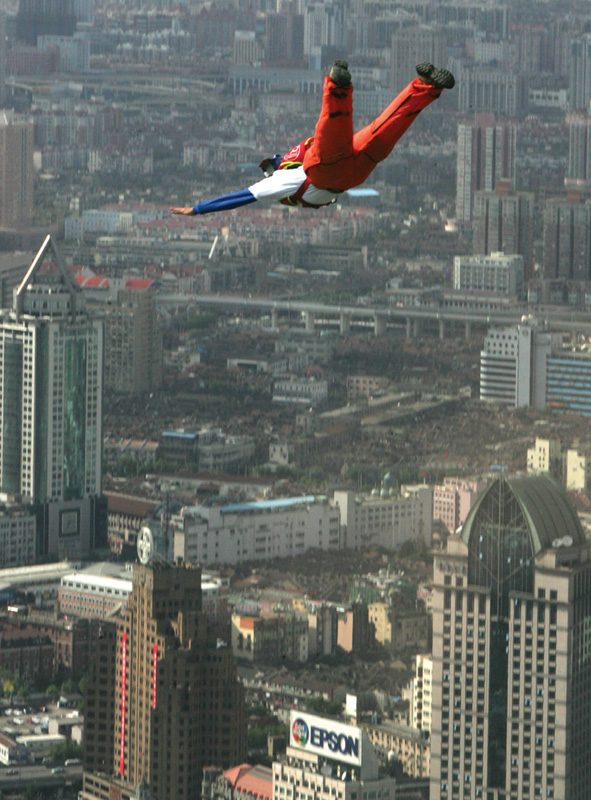
WHAT IT IS A chance to check out Newton’s theories from the top of the world’s tallest building
WHY YOU WON’T DO IT The ground is unforgiving and canvas a flimsy fabric to which to trust your life
Base jumping is the sport of jumping with a parachute from a fixed point – in effect, it’s a radically truncated form of skydiving. The word ‘BASE’ itself is an acronym standing for the various categories of fixed object: buildings, antennae, spans (bridges) and earth (more often than not, cliffs). So how about trying it from the tallest building in the world?
As you could probably guess, base jumping is dangerous, foolhardy and, in a great many places, illegal. One early exponent was Franz Reichelt, an Austrian-born French tailor who launched himself from the top of the Eiffel Tower in 1912 in order to test his newly invented ‘parachute coat’. Reichelt’s aims were noble – he hoped that his suit would save aviators who were unexpectedly forced to bail out of their aircraft – and the authorities had granted permission for his test on the assumption that Reichelt would be using a dummy. However, showing impressive but unwarranted faith in his own invention, the ‘Flying Tailor’ insisted he would test the device himself, and paid the price when his parachute failed to deploy and he died on impact.
Reichelt’s lesson seems to have discouraged others from following in his footsteps for more than half a century, and by the time the idea was resurrected as a modern ‘extreme sport’ in the late 1970s, parachute technology had changed almost beyond recognition.
The highest jump from a building so far was achieved in 2010 by Omar Al Hegelan and Nasr Al Niyadi, when they plummeted from the Burj Khalifa skyscraper in Dubai, the tallest manmade structure in the world at 828 metres (2,717 ft). Their jump involved an impressive ten seconds of free fall before their parachutes activated. They survived, but the sport’s estimated death rate is staggering – ultimately accounting for around one in sixty participants. No one is going to better Al Hegelan and Al Niyadi’s record until someone builds a taller tower, but you could at least try to equal it.
You’ll need to undertake specialist training with an experienced base jumper and, meanwhile, build up your experience of normal skydiving. (No one said this would be easy.) On average, a base jumper will have completed around a hundred ‘ordinary’ skydives before attempting his or her first jump. In time, your trainer will become a trusted mentor who can let you know when you’re ready to take the next step.
Buy your tickets for Dubai (returns if you’re feeling lucky), and check your life insurance premiums are up to date (if they’ll even cover you for this sort of thing). You’d also better ask the owners for permission to jump: the 2010 jump was carried out with the blessing of the Dubai authorities, but two years previously (before the official opening), a Briton and a Frenchman disguised as engineers snuck into the building and launched themselves from a balcony between the 150th and 160th floors.
Do your homework – go and see exactly where you’ll be jumping from and keep a special lookout for any unexpected impediments or obstacles.
On the day of your jump, ensure your specially made base-jumping parachute (typical price, US$1200–$1500) is properly packed. Base jumpers favour the ram-air parachute – a rectangular design that allows for greater control of speed and direction. Because of the shortage of time, some jumpers opt to open their pilot chute (the one that pulls the main chute open) manually, rather than with a ripcord. You should just about have time enough to employ a slider that opens the parachute slowly to avoid troublesome tangled lines and violent jolts.
Check your back-up parachute too – you’ll have just about have enough time to deploy it in an emergency, For jumps below 600 metres (2,000 ft), there’s no point in a back-up as by the time your main chute has failed, you’ll already be intimately familiar with the ground. Jumpers from lower heights instead tend to employ a slightly larger pilot chute, which ensures the main chute not only opens more quickly, but is also more effective at the lower velocities generated by a shorter jump.
DON’T LOOK DOWN When it opened in 2010, the Burj Khalifa in Dubai officially became the world’s tallest building. Rising almost 830 metres (2,720 ft) into the sky, its chief architect was Adrian Smith of Chicago firm Skidmore, Owings and Merrill. Construction of the 163 floors cost a total of US$1.5 billion, but the project had to be bailed out with money from Abu Dhabi following the global financial crisis.
Take one last look for any new obstacles on the ground below, and step out into the unknown. Be sure to get some distance between you and the side of the building – hitting the side of the tower could be just as lethal as hitting the ground. Release the pilot chute at around 600 metres (2,000 ft) and steer yourself to a safe landing. Just don’t forget to dodge any window cleaners you pass on the way down – it’s a non-stop job and it takes a team of 36 workers up to four months to clean all of the tower’s windows.